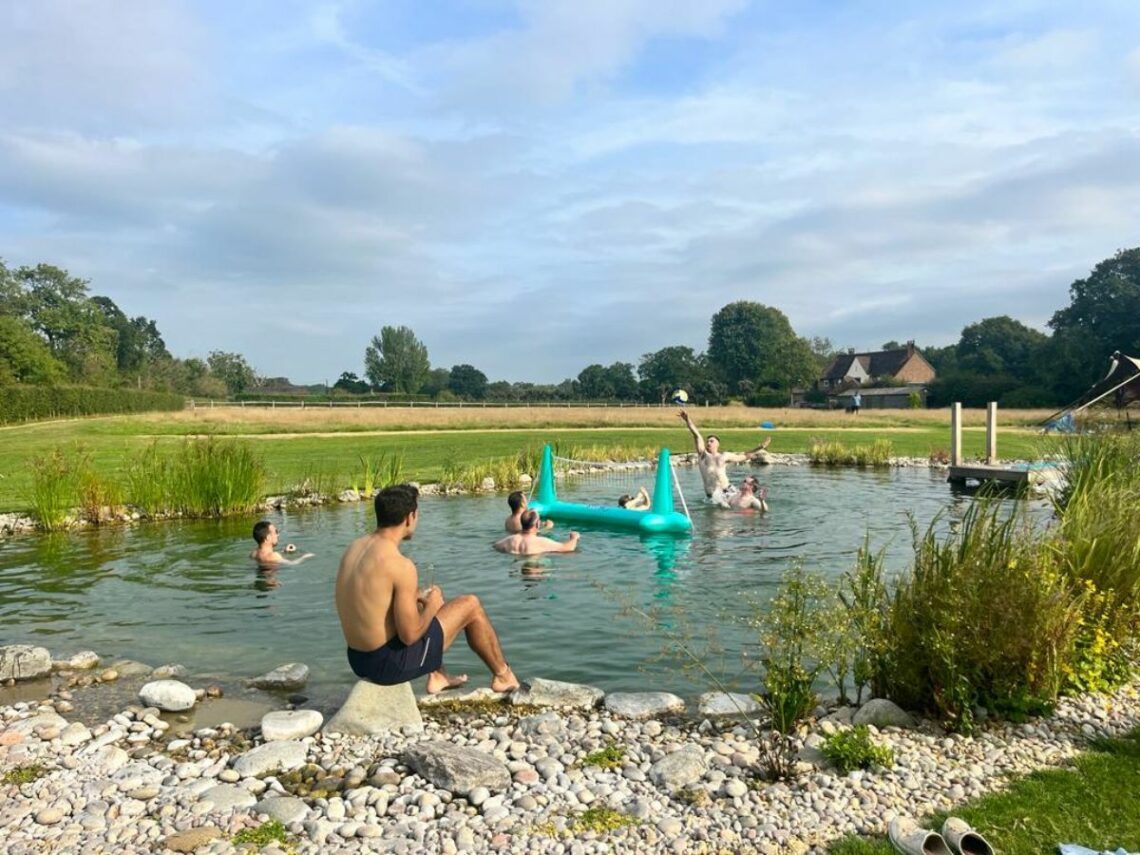Yes, you can swim in a pond. A pond provides a natural and tranquil setting for swimming, allowing you to immerse yourself in cool, clear water surrounded by picturesque nature.
The Pond Ecosystem
Ponds are vibrant ecosystems that support a diverse range of flora and fauna. Let’s explore the intricate web of life within a pond, starting with the fascinating world of Flora and Fauna:
Flora And Fauna
Ponds are teeming with plant and animal life, creating a delicate balance. The aquatic plants and algae serve as the foundation for the food chain.
- Water lilies, duckweed, and cattails thrive in ponds, providing habitats for various organisms.
- Fish, frogs, turtles, and insects are common inhabitants of pond ecosystems, each playing a vital role.
Biodiversity Hotspot
Ponds are considered biodiversity hotspots due to the wide array of species they support. This diversity is crucial for a healthy ecosystem:
- Multiple species of plants and animals coexist harmoniously in ponds, promoting ecosystem resilience.
- From tiny microorganisms to larger vertebrates, ponds host a remarkable variety of life forms.

Credit: www.pondandgardendesign.co.uk
Pond Water Composition
Before knowing can you swim in ponds you should have a clear idea about the pond water where you are going to or thinking about swimming. Understanding the composition of pond water is crucial before deciding whether it’s safe to swim in. Let’s delve into the key components:
Oxygen Levels
Oxygen Levels in a pond are essential for aquatic life to thrive. Fish and other organisms require sufficient dissolved oxygen to survive.
Nutrient Content
Nutrient Content in pond water determines its overall health. Excessive nutrients can lead to algae blooms, affecting water quality.
Health Risks And Safety Precautions
When it comes to swimming in a pond, it’s important to be aware of the potential health risks and take necessary safety precautions to ensure a safe and enjoyable experience. From bacterial hazards to physical dangers, understanding these risks is essential for anyone considering a refreshing dip in a pond.
Bacterial Hazards
Ponds can be breeding grounds for harmful bacteria, including E. coli and other pathogens. These bacteria can enter the water through animal waste, agricultural runoff, or sewage, posing a risk to swimmers.
Exposure to these bacteria can lead to stomach cramps, diarrhea, and other gastrointestinal issues. Additionally, open wounds or cuts can become infected if exposed to contaminated pond water. It’s crucial to be mindful of the potential bacterial hazards before taking a plunge in a pond.
Physical Hazards
- Underlying hazards such as sharp rocks, debris, and plants can pose a threat to swimmers
- Poor visibility in murky water increases the risk of accidental injuries
- Uneven terrain around the pond can lead to slips and falls
Wearing water shoes and conducting a thorough visual assessment of the pond’s surroundings can help mitigate these physical hazards.

Credit: deckandpatio.com
Human Impact On Pond Ecosystems
Humans have a significant impact on pond ecosystems. The actions and behaviors of individuals can directly influence the health and balance of these fragile habitats. In this section, we will examine two key ways in which human activities can negatively impact pond ecosystems: pollution and habitat destruction.
Pollution
Pollution poses a severe threat to the delicate balance of pond ecosystems. The release of harmful substances into the water can have devastating effects on the plants and animals that call the pond home. Some common sources of pollution include:
- Industrial waste: Chemicals and toxins from nearby industries can contaminate the water, impairing the survival and reproduction of aquatic organisms.
- Agricultural runoff: Excessive use of fertilizers and pesticides in nearby farms can wash into the pond, leading to nutrient imbalances and toxic conditions for aquatic life.
- Sewage and wastewater: Improperly treated sewage and wastewater can introduce harmful bacteria, viruses, and excess nutrients into the pond, disrupting the natural ecosystem.
Habitat Destruction
Habitat destruction is another significant impact of human activities on pond ecosystems. As human populations expand and develop, ponds often face the threat of being altered or destroyed altogether. Some common causes of habitat destruction in ponds include:
- Urbanization and construction: The conversion of natural land into urban areas or the construction of buildings and infrastructure near ponds can disrupt the natural habitat and lead to the loss of critical resources for pond organisms.
- Deforestation: Clearing forests near the pond can increase sediment and nutrient runoff into the water, smothering aquatic plants and disrupting the overall balance of the ecosystem.
- Draining and dredging: The drainage and dredging of ponds for land use purposes, such as agriculture or expansion of human settlements, can result in the complete loss of the pond and its diverse array of species.
Legal And Ethical Considerations
When considering swimming in a pond, it is essential to be mindful of the legal and ethical aspects. Various regulations and responsibilities come into play, ensuring a safe and enjoyable experience for all.
Environmental Regulations
Ponds are often subject to environmental regulations aimed at preserving the ecosystem. These regulations may dictate restrictions on swimming to prevent habitat disruption and water contamination. It is crucial to abide by these rules to maintain the pond’s ecological balance.
Responsible Recreation
Engaging in responsible recreation means respecting the pond’s natural environment and other individuals’ rights. Avoid littering, damaging vegetation, or disturbing wildlife to ensure the pond remains a pristine and welcoming space for everyone to enjoy.
Pond Conservation And Restoration
Pond conservation and restoration are crucial efforts in preserving the natural habitats and biodiversity of these valuable ecosystems. Through community involvement and restoration initiatives, people can play a significant role in protecting and reviving the health of ponds. This article explores the importance of pond conservation and restoration and the positive impact that community engagement and specific restoration initiatives can have on these delicate environments.
Community Involvement
Community involvement is a fundamental aspect of pond conservation and restoration. By educating and engaging local residents, communities can become active participants in preserving the health of ponds. Activities such as organized clean-up events, educational workshops, and volunteer opportunities empower individuals to contribute to the protection of their local ponds.
Restoration Initiatives
Restoration initiatives are essential for reversing the damage sustained by degraded ponds. Through the implementation of targeted restoration efforts such as invasive species removal, native plant re-vegetation, and erosion control measures, the functionality and biodiversity of ponds can be improved.
These initiatives aim to restore the natural balance of pond ecosystems, promoting the return of native flora and fauna while mitigating the impact of human activity.
Frequently Asked Questions
Q: What should I do if I encounter algae or other potential hazards while swimming in a pond?
A: Promptly exit the water and avoid contact with the algae. Rinse off any exposed skin with clean water and seek medical attention if you experience any adverse reactions.
Q: Are there any techniques or skills I should learn before swimming in ponds?
A: It’s beneficial to learn basic water safety skills, such as treading water, floating, and swimming strokes. Additionally, understanding how to recognize and respond to potential hazards like currents or underwater obstacles can enhance safety.
Q: How can I ensure that I don’t disturb the ecosystem of a pond while swimming?
A: Minimize your impact by avoiding trampling vegetation, disturbing wildlife, or leaving behind litter. Swim gently, refrain from touching or disturbing aquatic plants and animals, and follow any posted guidelines for protecting the environment.
Q: Are there any specific areas within a pond where swimming is safer or more advisable?
A: Choose areas with clear water, good visibility, and minimal hazards like rocks or submerged vegetation. Avoid areas with strong currents, deep drop-offs, or known hazards to ensure a safer swimming experience.
Q: What should I do if I accidentally swallow pond water while swimming?
A: Spit out any water immediately and avoid swallowing more. Rinse your mouth thoroughly with clean water. If you experience any symptoms such as nausea, vomiting, or diarrhea, seek medical attention promptly.
Q: Can swimming in ponds affect my skin or hair differently than swimming in pools or the ocean?
A: Yes, pond water may contain different levels of minerals, bacteria, and other substances compared to pool or ocean water. Some individuals may experience skin irritation or dryness from prolonged exposure to pond water. Rinse off after swimming and moisturize to help mitigate any effects.
Q: How can I safely enter and exit a pond for swimming?
A: Look for gradual entry points with shallow water and clear visibility. Check for any underwater obstacles or hazards before entering. When exiting, use caution to avoid slipping on wet or uneven surfaces.
Q: Are there any specific clothing or gear recommendations for swimming in ponds?
A: Wear appropriate swimwear for comfort and mobility. Consider wearing water shoes to protect your feet from sharp objects or rough surfaces. Additionally, use sunscreen to protect your skin from sun exposure while swimming in ponds.
Final Words
Swimming in a pond can be an enjoyable and refreshing experience. However, it’s important to consider potential risks such as water quality and safety hazards. By taking necessary precautions and being mindful of your surroundings, swimming in a pond can be a safe and pleasurable activity for all.





